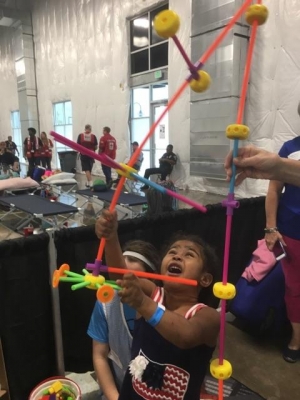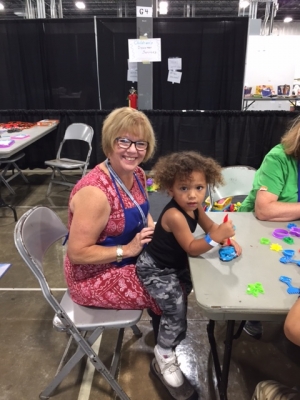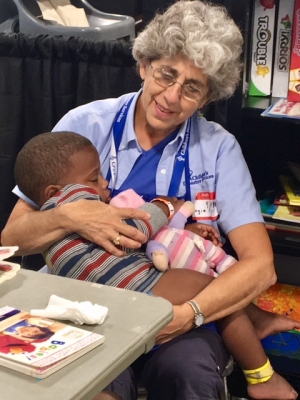news article
Upper New York Helps Children in Texas and Florida: Interview with the Rev. Cathy Hall-Stengel
September 25, 2017 / By Shannon Hodson / .(JavaScript must be enabled to view this email address)
United Methodists have a long history of responding to communities in the midst of disaster though the Unit ed Methodist Committee on Relief (UMCOR), Volunteers-in-Mission (VIM), and Conference and District disaster response teams, and partnerships with other organizations.
ed Methodist Committee on Relief (UMCOR), Volunteers-in-Mission (VIM), and Conference and District disaster response teams, and partnerships with other organizations.
One organization that UNY Methodists are regularly involved with helps children impacted by natural disasters. Through Children’s Disaster Services, which historically has been connected to the United Methodist Church, a number of people from UNY have been at the frontlines in Texas and Florida.
While Children’s Disaster Services (CDS) is currently operated by the Church of the Brethren, several United Methodists have been trained members of this critical ministry for a very long time. The Rev. Cathy Hall Stengel is one of them.
We caught up with Rev. Hall Stengel to learn more about CDS and her recent involvement at a disaster relief shelter in Austin, Texas, working with children who had been displaced from their homes in the aftermath of Hurricane Harvey.
Shannon Hodson: Can you tell me a little bit about Children’s Disaster Services?
Rev. Cathy Hall-Stengel: We are trained, background checked, and prepared through education and communication. We are pastors and Christian educators; we are laity who also serve Annual Conferences across the Connection.
Children’s Disaster Services helps children impacted by natural disaster, usually in a shelter setting. We provide safe, official childcare while parents are tending to paperwork, needs, or just getting a shower and a nap.
The children have an opportunity to play. Play-Doh, paint, cars, cardboard boxes, dolls, building toys, and dress-up clothes provide the foundation for letting the children interact with adults.
The children also have an opportunity to be held, to rest, to get all of the attention (where possible) from an adult who has NOT also experienced the disaster. The children get a chance to be in a non-anxious place to either tell their story, or dream up a new one in an affirming environment.
The Red Cross has determined the CDS is to be deployed as the disaster takes place as a part of urgent response teams. We arrive at shelters, set up a safe space (with a perimeter) for children to be cared for. We sign children in and out, parents and children receive wristbands so that all children are accounted for and released only to the parent, grandparent, or other authorized adult.
The CDS volunteers I know have been to New York City for 9/11, to Moore Oklahoma for the tornado disaster, wild fires in the West and Midwest, Katrina,  Matthew, Sandy, Harvey, Irma and other storms that don’t even get named.
Matthew, Sandy, Harvey, Irma and other storms that don’t even get named.
Shannon Hodson: That sounds like such a great service. Can you describe some specific experiences of your own working with children in the aftermath of a disaster?
Rev. Cathy Hall-Stengel: There are so many rich and wonderful experiences with the children, it’s hard to choose. Here are some experiences that come to mind from the 12 days I spent in Austin, Texas after Hurricane Harvey:
A little boy was painting a picture and wanted me next to him to watch. I watched as he created his apartment building, his home, the home he had lived in since his family escaped from Baton Rouge just one year ago. He told me the water was dark and green, not swimming water. He and his mother and brother watched as the water came closer and closer to the windows on the second floor; snakes were swirling in the floodwaters. The rain and wind were very scary; his mother was crying and his grandmother was praying. A military boat came to their window and took them to safety. He wondered about his toys, but more than anything he wanted his mother to feel safe and warm.
Then, there was Zoe, a vivacious and beautiful little five-year old who spent a while playing in our rice box (rice is used as a sensory tool for expression). She lifted up a handful of rice and sprinkled it down on the box – her words were: “The rice falls like the wind and rain that took our roof away.” Zoe didn’t need to talk about it any further; she just needed to say it.
There was also Tierra, a very young mother. She came to the shelter in Austin with a three-week old little girl, Jemilyah, and a two-and-a-half-year old, Tyler. Their cot assignment at the shelter put them right next to our child care. They had escaped the “drowning of their home.” Shaken and overwhelmed, Tierra struggled to care for her two small children. Without even having to come to a team consensus about this family, we began the work and ministry of support, encouragement,  and baby holding. Our ministry was so much more than just childcare.
and baby holding. Our ministry was so much more than just childcare.
Shannon Hodson: Wow, I can tell those experiences touched your heart. Can you describe to me the training you had to go through to become a volunteer for CDS?
Rev. Cathy Hall-Stengel: I was trained to be a volunteer for Children’s Disaster Services in 2014 at the Victor United Methodist Church. Trainers are trained by those who have been trained….like our Safe Sanctuary programs. Dot and Terry Norsen, who have been active in the life of the Victor United Methodist Church, the Genesee Valley District, and the Upper New York Conference helped to make this training happen.
The training involves an overnight, on the floor or on a cot to simulate shelter life. Training involves team building and organization of shelter space. We spent hours learning about expressive play, safety needs, and how to help children deal with the disaster they’ve experienced. We learned about redirecting behavior rather than saying no to the children. Each trainee is obligated to have an extensive background check in order to receive credentials and must attend additional training every four to five years to maintain available status.
Shannon Hodson: And is there an expense for volunteers associated with their deployments?
Rev. Cathy Hall Stengel: When a volunteer is deployed – they are actually deployed by the Red Cross. CDS assembles the teams, the Red Cross makes airline reservations, makes sure there are accommodations at the disaster site, which could be a staff shelter or a hotel (it varies), and provides for meals and other expenses. There is virtually no out-of-pocket cost for the actual experience in deployment. If there are out-of-pocket costs (luggage fees, meals while traveling, parking or transportation) those are all reimbursed by the Red Cross.
Shannon Hodson: That is incredible. How can our Conference members learn more about CDS?
Rev. Cathy Hall Stengel: You can visit their website to learn more, including upcoming trainings.